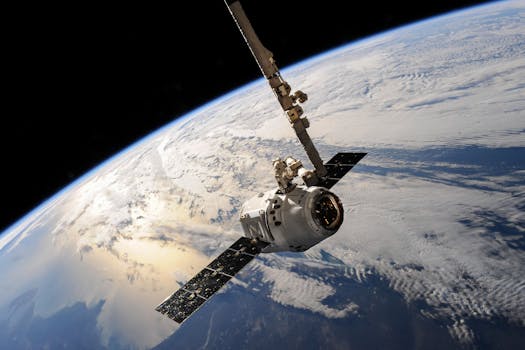The Future of Satellites: Revolutionizing Global Connectivity and Beyond

The future of satellites is a topic of great interest and importance, as these space-based systems play a crucial role in enabling global connectivity, navigation, and remote sensing. With the rapid advancement of space technology, satellites are becoming increasingly vital to our daily lives, and their impact is expected to grow exponentially in the coming years. Future of satellites is an exciting and rapidly evolving field, with new developments and innovations emerging regularly.
One of the primary areas where satellites are making a significant impact is in the field of global connectivity. With the increasing demand for high-speed internet and reliable communication, satellites are being used to provide broadband services to remote and underserved areas, where traditional fiber-based infrastructure is lacking. This is particularly important for developing countries, where access to the internet and other digital services can be a major challenge. Companies like SpaceX, Amazon, and OneWeb are leading the charge in this area, with plans to launch thousands of satellites into low-Earth orbit to provide global coverage and connectivity.
In addition to global connectivity, satellites are also playing a critical role in navigation and remote sensing. GPS technology, which relies on a network of satellites orbiting the Earth, has become an essential tool for navigation, mapping, and tracking. Satellites are also being used for remote sensing applications, such as monitoring weather patterns, tracking climate change, and detecting natural disasters. The use of satellites in these areas is not only improving our understanding of the Earth and its systems but also enabling us to respond more effectively to natural disasters and other crises.
The future of satellites is not without its challenges, however. One of the major concerns is the growing problem of space debris, which poses a significant threat to the long-term sustainability of space exploration and development. As the number of satellites in orbit increases, so does the risk of collisions and other accidents, which can generate even more debris and create a hazardous environment for spacecraft and satellites. To address this issue, companies and governments are working together to develop new technologies and regulations for responsible satellite operations and debris mitigation.
Another area where satellites are expected to have a major impact is in the field of space exploration and development. With the rise of private space companies like SpaceX, Blue Origin, and Virgin Galactic, there is a growing interest in using satellites and other space-based systems to support deep space missions and colonization efforts. Satellites can provide critical communication and navigation services for spacecraft, as well as enable remote sensing and monitoring of celestial bodies. As humanity begins to explore and settle other planets, satellites will play a vital role in enabling and supporting these efforts.
In conclusion, the future of satellites is a bright and exciting one, with many opportunities for growth, innovation, and exploration. As technology continues to advance and new developments emerge, satellites will become increasingly vital to our daily lives, enabling faster and more reliable communication, navigation, and remote sensing. Whether it’s providing global connectivity, supporting space exploration, or enabling remote sensing applications, satellites are poised to play a major role in shaping the future of our world and beyond.
The use of satellites in various fields is expected to continue growing, with new applications and innovations emerging regularly. As we look to the future, it’s clear that satellites will remain a critical component of our global infrastructure, enabling us to communicate, navigate, and understand our world in ways that were previously unimaginable. With their ability to provide global coverage, enable remote sensing, and support deep space missions, satellites are an essential tool for a wide range of industries and applications, from telecommunications and navigation to environmental monitoring and space exploration.
As the satellite industry continues to evolve, we can expect to see new technologies and innovations emerge, such as advanced propulsion systems, more efficient power sources, and improved communication protocols. These developments will enable satellites to operate more efficiently, effectively, and sustainably, with reduced costs and increased capabilities. The future of satellites is a complex and multifaceted one, with many challenges and opportunities ahead. However, with continued investment, innovation, and collaboration, it’s clear that satellites will remain a vital part of our global infrastructure, enabling us to connect, explore, and understand our world in ways that were previously unimaginable.
The impact of satellites on our daily lives is already significant, and it’s expected to grow exponentially in the coming years. From enabling global connectivity and navigation to supporting space exploration and remote sensing, satellites are playing an increasingly vital role in our world. As we look to the future, it’s clear that satellites will remain a critical component of our global infrastructure, enabling us to communicate, navigate, and understand our world in ways that were previously unimaginable. With their ability to provide global coverage, enable remote sensing, and support deep space missions, satellites are an essential tool for a wide range of industries and applications.
In the coming years, we can expect to see significant advancements in satellite technology, with new developments and innovations emerging regularly. The use of satellites in various fields is expected to continue growing, with new applications and innovations emerging regularly. As we look to the future, it’s clear that satellites will remain a critical component of our global infrastructure, enabling us to communicate, navigate, and understand our world in ways that were previously unimaginable.
The future of satellites is a bright and exciting one, with many opportunities for growth, innovation, and exploration. As technology continues to advance and new developments emerge, satellites will become increasingly vital to our daily lives, enabling faster and more reliable communication, navigation, and remote sensing. Whether it’s providing global connectivity, supporting space exploration, or enabling remote sensing applications, satellites are poised to play a major role in shaping the future of our world and beyond. The impact of satellites on our daily lives is already significant, and it’s expected to grow exponentially in the coming years.
The use of satellites in various fields is expected to continue growing, with new applications and innovations emerging regularly. As we look to the future, it’s clear that satellites will remain a critical component of our global infrastructure, enabling us to communicate, navigate, and understand our world in ways that were previously unimaginable. With their ability to provide global coverage, enable remote sensing, and support deep space missions, satellites are an essential tool for a wide range of industries and applications, from telecommunications and navigation to environmental monitoring and space exploration.




